|
AN KHE
(538th Co) Almost unknown and unheard of, the small,
yet significant 538th Land Clearing Company, 35th Engineer
Group, has for the past few years been attacking some of the
most treacherous lands throughout Vietnam. With their
large D-7 Rome Plows, they are taming the jungles. |
|
The most recent operation completed by the 538th,
"mountain movers", was in Tam Quan district, near
Bong Son. Requested by the local villagers, the engineers
helped destroy the VC hold on the area. Those living in
this area were isolated: they had almost no contact with
the government. The thick jungle growth in the mountains
provided unlimited hiding places for the VC, while the
countless hedge-rows served as secure avenues of approach
and escape. Mines and booby traps also took their daily
toll on units operating in the area
The only solution was to destroy the enemy's
hiding places by transforming the jungle into an almost
barren, yet fertile land and eliminate his movement and to
relocate some of the villages which were spread out too
far for adequate security. |
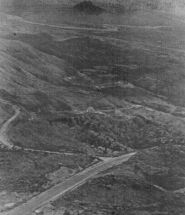 |
| An Khe
Pass is in the foreground while Highway 19 snakes among
the hills. |
|
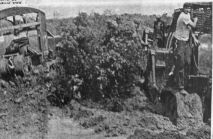 |
The plows rapidly set to work skimming an area of land,
clearing away mines. This was to be the company's night
defensive position (NDP) Only after the plows arrived at
the prospective NDP did the engineers realize they had
chosen a North Vietnamese Army (NVA) bunker complex to
build their homes. The enemy soldiers apparently had made
a hasty retreat from the area, since fires were still
burning, ice was found, and someone's laundry was left to
dry. |
|
For these
two D-7's, this might indeed be the "unkindest cut of
all". |
|
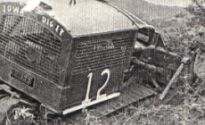 |
|
Other items were also found indicating "Charlie" had been
there within the last 20 minutes. During the next 40 days
of the operation, hundreds of tunnels and bunkers were
found and destroyed. Deciding that if the spot was good
enough for the NVA , it was good enough for the engineers,
the 538th began destroying the bunkers with the
monster-like bulldozers. Soon, they pushed up a five-foot
berm and plowed the inner surface, |
|
"Iowa
Dig It" finds the going rough in the sandy soil. |
|
|
leveling
spots for the tactical operations center (TOC) and mess, commo
and maintenance sections. Finally, they dug slots in the
berm for the tanks and armored personnel carriers (APCs) and
smoothed out areas for tents. Usually, an NDP is completed
within half a day and the plows begin clearing approximately
40 surrounding acres for security. |
|
Knee-deep into their
operation, the 538th was informed by Military Assistance
Command, Vietnam (MACV) personnel, that when they had built
their NDP, they buried alive an unknown number of NVA soldiers
in tunnels connecting each bunker. Captured enemy documents
supported this. |
|
During the operation, the land clearers worked closely with
the village chiefs and mobile advisory team. The men were
directed to stay away from houses, graves and crops. If they
were not sure about an area they would consult the village
chief before proceeding |
|
The terrain of Bong Son area is rough. Specialist 4 August
Frenzel, of Northolm, Minn., whose family owns a civilian land
clearing company, said, "I thought I had seen some rough
terrain in the states, but the operation in Bong Son would
have made the others look like Sunday gardening." |
|
Clearing the land is a dirty and dangerous job. The work-day
is long, beginning with a two-hour maintenance stand down.
Following the stand down is a single file drive to the cut, or
job site. Each man settles down in his cage-like cab, a
private world where even his thoughts are drowned out by the
roar of the diesel engine. |
|
The D-7's and their operators may disturb a nest of bees, who
usually turn out to be very non-appreciative. Specialist 5
John Conners, a dozer operator, recently became well aware of
bees when he received 96 stings on his head, hospitalizing him
for two weeks. |
|
These
pictures are of the dozer mentioned to the right in this
article. According to Sgt. Ingram of the 538th, the cab
of the dozer broke off landing upside down with Sp 5
Morris inside of the cage. |
The steep mountains which the 538th challenged took
their toll of men and equipment. Sharp slopes forced
the drivers to ride with feet braced against the
instrument panel to prevent falling from the cab. One
D-7, commanded by Specialist 5 Eugene Morris, while
clearing a mountainside, hit a bad spot which took both
the operator and dozer for an unwanted ride. The huge
machine bounced and banged its way down the
mountainside, landing 300 yards from where it started.
The operator jumped from the dozer. Cut and bruised,
the shook-up specialist walked back to the top and was
soon carried off by helicopter for medical attention.
The dozer was a total loss. Though the name "Rome
Plow" is general used when describing land clearing
operations, the engineers actually use two different
types of blades: |
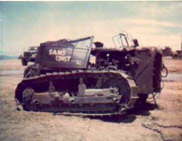 |
|
|
|
the Rome
blade and the Bull blade. The latter, which is a normal
bulldozer blade, works best in areas where the ground has to
be scraped clean below the surface. It is also valuable for
constructing camp sites and stream crossings. |
|
The Rome Blade is better
suited for the thick jungle. It has a sharp cutting edge and
is canted at a 30 degree angle so debris slides off to the
right as the plow moves along. |
|
The blade is also equipped with a 'stinger', a wedge like
projectile mounted on the leading left edge which allows the
operator to split larger trees before felling them with the
cutting edge. |
|
The large steel blades have saved many lives on the cut. The
engineers usually lead the way into the area, exposing
themselves to mines and booby-traps. "Most mines hit, will
shake up the driver quite a bit, but usually the blade will
take most of the blow, sending shrapnel in another direction,"
stated Specialist Bill Fischer, of Kansas City, MO., a medic. |
When land clearing, the
APC's and tanks follow in the plows tracks.
When the plows returned in the early evening, they
could be heard from the camp long before they were
sighted. The earth began to shake a little, and the
noise grew louder. The hungry, tired, thirsty, dirty,
sweaty, jungle clearers were back. |
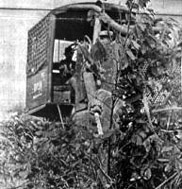 |
|
Once inside the berm, the men jumped from their cabs and
headed straight for tents to get beer or soda. Covered
with dirt, the men stripped off their clothes and headed
toward the water truck. Nothing in the world would feel
better at the moment than a cold shower and a hot
dinner. |
|
Near the finish of the Bong Son operation, the area was
under the control of the Popular and Regional Forces.
The villages lived in relative peace, not fearing the
nightly raids of
|
This
member of the third herd is pushing its weight
around-all 34 tons of it |
|
|
the VC which once plagued their homes. A total of 21
mines were discovered by the 538th. There was one GI killed in
action and eight others wounded. |
|
An hour and a half drive took the engineers to Cha Rang
Valley. After 45 days in the field, they relaxed, recuperated
and repaired any damages to their dozers in preparation for
another 45 to 60 days in the field. As always for the 538th,
the main event of the stand down party was the baptisms. Each
man E-5 or above was lifted by approximately six men E-4 and
below, immersing them into a large tub of ice water. Once the
person is completely under water, the lowest-ranking person
will OK his release. |
|
"There is never any hard feelings about this tradition,"
stated Sergeant First Class Lawrence E. Tregoning, "even the
commanding officer received this honor." |
|
Floor Shows brought color
to the stand down. One man said it was like seeing television
after the set had been broken for six months. |
|
Pulling out of Cha Rang
Valley, trucks take men and dozers of the 538th to another
area. This time, the location is the treacherous An Khe Pass. |
|
"Thick vegetation on both sides of National Highway 19,
running through the pass, provides good enemy cover and
concealment, for sporadic ambushes on U.S. and Vietnamese
convoys," said First Lieutenant Sher G. Singh, the acting
commander. "Our job is to clear 200 yards on either side of
the highway, thereby forcing the enemy into the open to
effectively ambush any traffic on the road. Also, this
operation will eliminate the need for more security in the
pass." |
|
"I think enemy harassment will be a factor in how long the job
takes," said First Sergeant Noble Brown, "however, the largest
problem I think we will run into will be marshland and quick
sand." |
|
The first day proved the First Sergeant correct, as both soft
stream beds and quicksand sank at least fifteen of the 25
dozers. |
|
From the top of An Khe Pass to Pleiku, 200 yards on both sides
of National Highway 19 was to be cleared, close to 80 miles of
road. |
|
This cut is near completion. More land is stripped of its
vegetal skin. The 538th's mission in Vietnam remains yet
unfinished. |
|
Article
submitted by: Steve Jones |